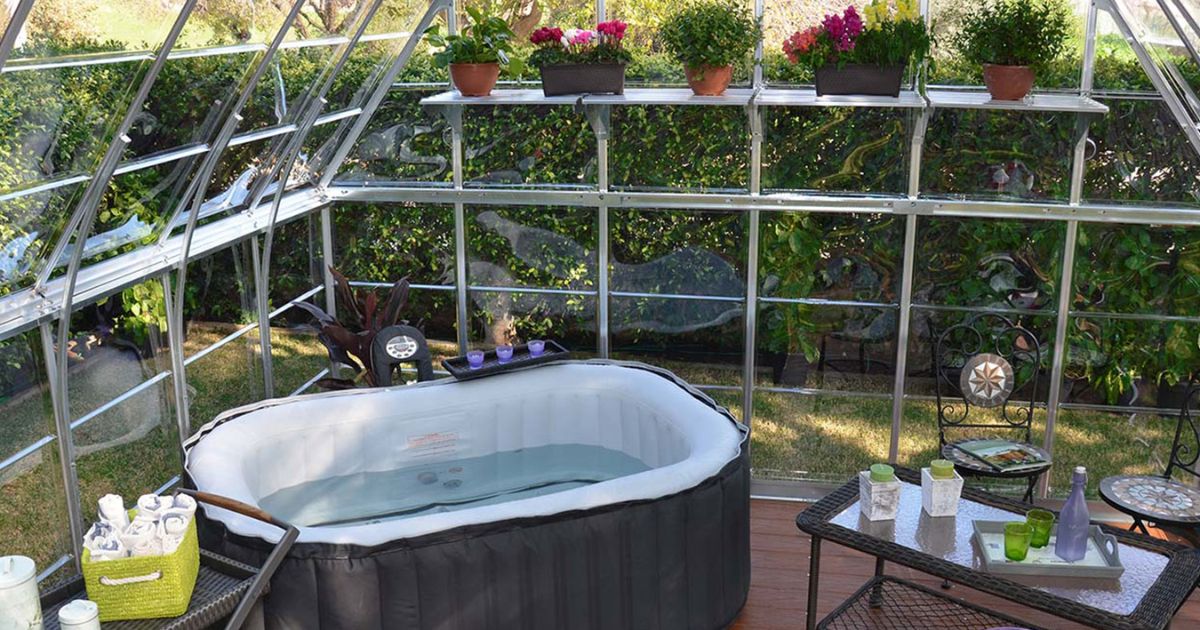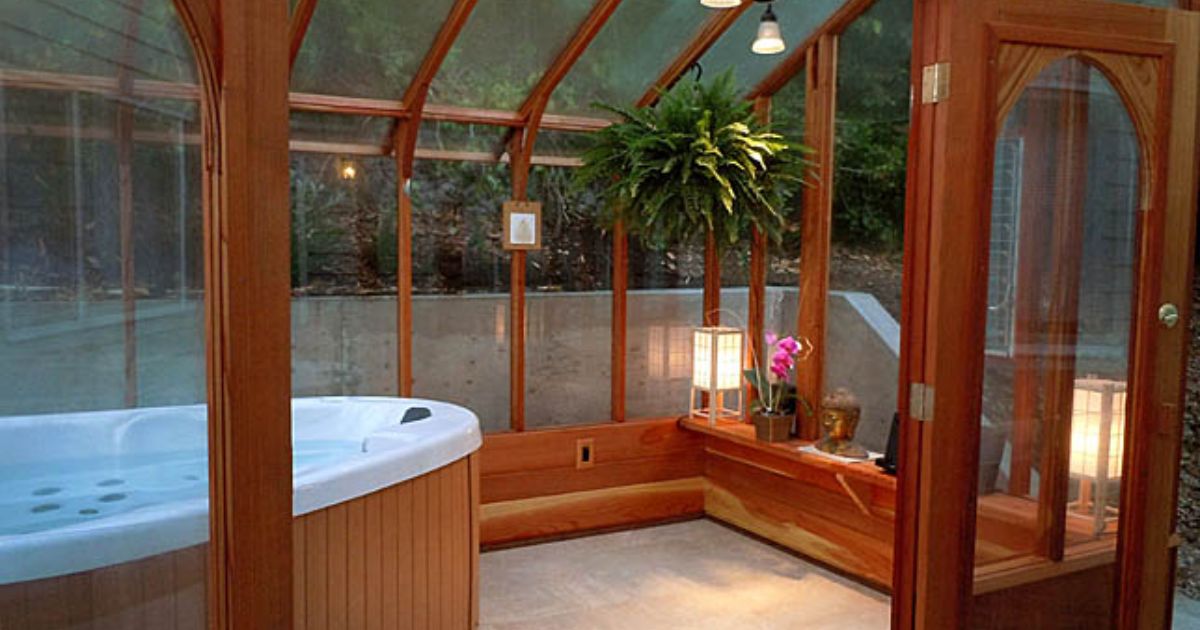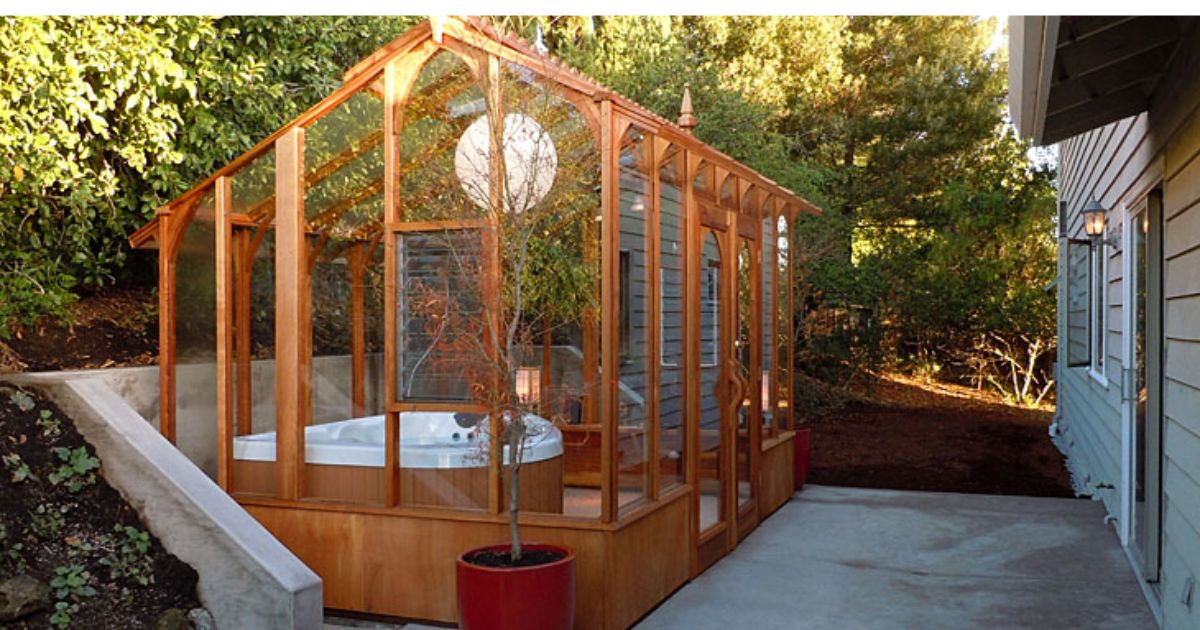Imagine being surrounded by others while relaxing in a warm, bubbling hot tub, encircled by a greenhouse’s beautiful vegetation, regardless of the season or the weather outside. Combining a hot tub with a greenhouse isn’t just a unique design idea; it’s a way to create a year-round relaxation haven that blends comfort, nature, and privacy.A greenhouse protects from rain, wind, and snow so you can enjoy your hot tub throughout the chilly winter months. It also creates a cozy, spa-like atmosphere where you can unwind amid plants, natural light, and fresh air.
In this guide, we’ll explore everything you need to know about installing a hot tub in a greenhouse, including planning, safety considerations, design tips, and maintenance strategies. Whether you’re a gardening enthusiast, a spa lover, or someone looking to upgrade your backyard experience, this article will help you turn your greenhouse into the ultimate relaxation retreat.
Why Put a Hot Tub in a Greenhouse?
Installing a hot tub inside a greenhouse may seem unusual, but it offers many advantages that make it a worthwhile investment for both comfort and aesthetics.
Year-Round Use:
A greenhouse lets you enjoy your hot tub year-round, even when it’s cold, rainy, or snowy outside. ideal greenhouse temperature and humidity The enclosed space traps heat, allowing you to soak in warmth even during the harshest winter months.
Protection from the Elements:
Unlike an outdoor hot tub exposed to wind, rain, and debris, a greenhouse provides shelter, keeping the water cleaner and reducing maintenance. How to Trim a Tree That Is Too Tall It also protects the tub’s structure and equipment from weather-related wear and tear.
Cozy and Private Environment:

A greenhouse creates a secluded retreat where you can unwind without worrying about your neighbors or others. It’s a perfect spot for unwinding after a long day, meditating, or spending quality time with family or friends.
Enhanced Aesthetic Appeal:
Combining plants with a hot tub enhances the overall ambiance, giving your backyard or garden a spa-like feel. You can surround your hot tub with greenery, flowers, or even small trees, turning the space into a tranquil oasis.
Increased Property Value:
A well-designed hot tub greenhouse is a unique feature that can boost your home’s value. It’s both functional and visually appealing, making it an attractive selling point for potential buyers.
By placing a starting seedlings in a greenhouse, you combine the therapeutic benefits of hydrotherapy with the serenity of nature, creating a luxurious space that can be enjoyed year-round.
Choosing the Right Greenhouse for a Hot Tub
When you’re planning to install a hot tub inside a greenhouse, selecting the proper structure is critical. This isn’t just about plants anymore. Here are the key considerations to help you choose a greenhouse that works well for both a hot tub and a comfortable spa‑like environment.
Size & Structural Capacity
- Ensure the greenhouse is large enough to accommodate the hot tub plus room for steps, Small Garden Design Ideas for Every Space and Budget cover removal, and servicing.
- The floor or foundation must support the weight of a full hot tub (water, tub, and people). Many greenhouses designed for plants may not have a strong enough base.
- Consider headroom and door access: you’ll need enough clearance for both the tub’s entry/exit and ventilation/maintenance.
Flooring & Base Requirements
- A level, durable base, such as a concrete pad or reinforced slab, is preferable to gravel or bare ground, which may shift or degrade under heavy tub weight.
- Waterproofing and drainage are essential, as splashes, steam, and humidity will be higher than in a typical greenhouse. Choosing flooring materials that can handle moisture is key.
Materials & Insulation
- The Greenhouse spa setup covering material affects both insulation and light/heat behaviour:
- Traditional glass looks excellent but is less insulating and may overheat or break under certain conditions.
- Polycarbonate panels or acrylic are more durable, better insulated, and often safer in wet environments.
- Sound insulation helps retain heat in cooler seasons, especially valuable when operating a hot tub, thereby reducing energy costs.
Ventilation & Humidity Control
- With a hot tub inside, you’ll generate significant steam and moisture. Proper ventilation is non‑negotiable to avoid mildew, corrosion, or structural damage.
- Choose a greenhouse with options for roof vents, side vents, or mechanical exhausts. Even in a plant greenhouse, Indoor hot tub installation ventilation is emphasized; in a hot tub scenario, it becomes even more critical.
Access to Utilities
- A hot tub will require electricity, water supply, and possibly drainage or overflow handling. When planning your greenhouse structure, ensure these utilities are accessible and installed safely.
- Consider the HVAC or heating system: the greenhouse may need a heater in colder months and cooling/shading in hotter ones, especially with the combined effects of tub heat and sun exposure.
Safety & Regulatory Considerations
- Confirm building codes and zoning: combining a greenhouse with a hot tub may trigger additional safety requirements (e.g., tempered glass, childproof access, slip-resistant surfaces).
- In a humid environment, How to Choose Deer Resistant Plants for Every Season electrical safety requires the use of ground-fault circuit interrupters (GFCIs) and proper wiring.
- For materials: avoid panels that might warp under heat or degrade from high humidity; this helps ensure longevity and safety.
Seasonal Comfort & Climate Control
- In winter, the greenhouse can help retain heat, making your Hot tub greenhouse design usable year‑round.
- In summer, without proper ventilation or shading, the space may become too hot and uncomfortable. Choose shading options (like shade cloths) or materials that reduce solar gain.
- Balance between creating a warm, spa‑like environment and not turning into a sauna when the sun is high.
Selecting the Perfect Hot Tub
Here are key considerations to help you choose the idealYear-round hot tub relaxation for your space, particularly important when installing it in a greenhouse or other enclosed environment.
Size & Seating Capacity
- Think about how many people will use the tub regularly. For example, if it’s just you or a couple, a 2‑4 person model will suffice; for families or social use, go for 5‑7+ seats.
- Make sure to measure your space carefully: the tub footprint + clearance for access/maintenance.
- Consider the seating layout: bucket seats, loungers, and multi‑level benches all affect comfort.
Energy Efficiency & Insulation
- Because your tub may be inside a greenhouse (which can trap heat but also require ventilation), insulation and efficient heating become even more critical. Look for full-foam insulation, high-quality covers, and efficient pumps.
- Higher energy efficiency helps reduce ongoing costs. Don’t just focus on sticker price; focus on the long‐term cost of heating and maintenance.
Jets, Features & Build Quality
- Decide what kind of experience you want: pure relaxation, hydrotherapy (for back/neck/legs), or just social soaking. Jets’ placement, adjustability, and seating ergonomics make a difference.
- Materials matter: shell type (acrylic or rotomolded), and the durability of frame and cabinet materials is essential.
Installation & Utilities
- Ensure the base or floor can handle the weight: when filled with water and people, a tub can weigh tons. Especially relevant inside a greenhouse.
- Electrical requirements: many tubs require 240V hard‑wiring, a dedicated breaker, and may require special setup. If your greenhouse has limited access, this is key.
- Consider drainage, ventilation (especially when indoors), and service access.
Budget, Warranty & Dealer Support
- Hot tubs span a wide price range; don’t let low upfront cost blind you to higher operating/maintenance costs.
- Work with a reputable dealer that offers strong after-sales support, warranty, and service. Many purchases go wrong because of weak support.
Compatibility for Your Greenhouse Environment
- Since you intend to use the tub in a greenhouse, make sure the model can handle a range of ambient temperatures (cold in winter, warm in summer).
- Ventilation and humidity control will be critical. Choose a tub that maintains temperature efficiently without overworking the heating system in an enclosed space.
- Make sure the tub’s dimensions and cover removal are compatible with your greenhouse structure (ceiling height, access doors, etc).
- Pick the right size for your users and space.
- Prioritise insulation and energy efficiency given the enclosed environment.
- Review jets, comfort, and build materials for the experience you want.
- Check installation requirements (weight, electrical, drainage, access).
- Choose a reliable dealer and factor in long‐term costs, How Do You Know When a Tree Is Dead not just purchase price.
- And ensure it’s compatible with your greenhouse (space, ventilation, climate control).
Safety Considerations

Installing a hot tub inside a greenhouse creates a cozy and relaxing environment. Still, it also introduces unique safety challenges that must be addressed to protect both people and the structure.
Electrical Safety:
Hot tubs require high-voltage electricity, and combining this with a humid greenhouse environment can be risky if not done correctly. Ensure:
- A licensed electrician installs all wiring.
- To avoid shocks, use ground fault circuit interrupters (GFCIs).
- Keep electrical outlets and cords away from water and steam.
Ventilation:
Steam from the hot tub increases humidity, which can cause mold, mildew, and slippery surfaces. Proper ventilation is crucial:
- Install roof vents or exhaust fans to manage moisture.
- Allow for airflow around plants and structural components to prevent rot or corrosion.
Slip-Resistant Flooring:
Water splashes are inevitable. Choose flooring that reduces slip hazards:
- Non-slip tiles, textured concrete, or waterproof mats are ideal.
- Ensure water drains efficiently to avoid puddles forming near walkways.
Structural Integrity:
A full hot tub can weigh several tons. Confirm that the greenhouse floor can support the combined weight of:
- Water in the tub
- Hot tub shell and equipment
- People using it
Safety Covers and Barriers:
- Always use a sturdy cover when the tub is not in use.
- For homes with children or pets, consider barriers or lockable doors to prevent unsupervised access.
Fire and Heat Safety:
- Keep heaters, lighting, and electrical equipment properly rated for humid environments.
- Avoid placing flammable materials near the hot tub area.
By addressing these safety considerations, you can enjoy the luxurious experience of a hot tub greenhouse while minimizing risks, ensuring both your relaxation and peace of mind.
Tips for Maximizing Comfort and Longevity
To fully enjoy a hot tub in your greenhouse and ensure it lasts for years, focus on comfort, maintenance, and proper environmental management. Here are the key tips:
Control Humidity and Ventilation:
Steam from the hot tub can create a very humid environment, potentially affecting both plants and the greenhouse structure. Use roof vents, exhaust fans, or dehumidifiers to maintain adequate ventilation and prevent mold or mildew growth.
Maintain Water Quality:
Regularly test and balance the water’s pH, alkalinity, and sanitizer levels. Clean filters routinely and drain the tub as recommended by the manufacturer. This prevents scale buildup, corrosion, and bacterial growth, keeping the water safe and comfortable.
Use Quality Insulation and Covers:
A well-insulated tub retains heat efficiently, saving energy and keeping the water warm longer. Always use a durable, insulated cover when the hot tub isn’t in use to prevent heat loss, debris, and accidental falls.
Plant Integration and Aesthetics:
Adding greenery around your hot tub enhances comfort and creates a relaxing atmosphere. Choose plants that thrive in humid environments, but ensure they don’t interfere with ventilation or fall into the water.
Regular Structural Checks:
Inspect your greenhouse and tub foundation periodically. Check for leaks, structural weakness, or corrosion caused by humidity. Reinforce supports or repair minor issues early to avoid costly damage.
Seasonal Adjustments:
- In winter, ensure the greenhouse retains heat efficiently, and consider supplemental heating if needed.
- In summer, use shading options like shade cloths or retractable panels to prevent overheating.
Comfortable Accessories:
Add non-slip mats, cushioned seating, ambient lighting, and easy-access steps for a safer and more enjoyable experience.By following these tips, your hot tub greenhouse can provide a safe, comfortable, and luxurious retreat all year round, while extending the life of both your tub and greenhouse structure.
Design Ideas and Ambiance
Creating the perfect atmosphere in your hot tub greenhouse goes beyond functionality; it’s about relaxation, aesthetics, and sensory experience. Here are some design ideas to elevate both comfort and visual appeal:
Integrate Plants and Greenery:
Surround your hot tub with tropical plants, ferns, or flowering shrubs to create a natural oasis. Hanging plants or vertical gardens can save space while adding lush greenery. Choose humidity-loving plants that thrive alongside a hot tub.
Mood Lighting:
Install soft, warm lighting to enhance relaxation. Consider LED strips, solar-powered lights, or waterproof fairy lights around plants or along pathways. Dim lighting helps create a spa-like ambiance for evening use.
Natural Materials:
Use wood, stone, or bamboo for decking, seating, or decorative accents. These materials complement the greenery, giving the greenhouse a more organic, spa-inspired feel. Ensure all wood is treated for humidity resistance.
Privacy Solutions:
Maintain seclusion with frosted glass panels, curtains, or bamboo screens. This ensures a private retreat while still letting in natural light.
Seasonal Decor:

Rotate decorations with the seasons, like cozy throws and lanterns in winter, or vibrant flowers in summer, to keep the space inviting year-round.
Comfort Accessories:
Add cushioned seating, towels, robes, and storage areas for convenience. Non-slip mats and ergonomic steps make entry and exit safe and comfortable.
Water Features and Sound:
Consider adding small fountains or ambient sound elements to enhance the spa-like experience. What Do Bats Eat Gentle water sounds can increase relaxation and mask outside noise.
By thoughtfully combining greenery, lighting, natural materials, and comfort features, your hot tub greenhouse becomes a luxurious, year-round sanctuary where you can unwind, refresh, and enjoy nature in total comfort.
Conclusion
It takes more than just a distinctive design to install a hot tub in a greenhouse. Choice: it’s a way to create a year-round retreat that blends relaxation, nature, and comfort. By carefully selecting the right greenhouse, choosing a high-quality hot tub, and addressing safety, ventilation, and maintenance, you can enjoy a spa-like experience regardless of the weather outside.
With thoughtful design, ambient lighting, and plant integration, your greenhouse becomes a private oasis that enhances both your home and your lifestyle. Regular care, proper water management, and attention to structural integrity ensure the longevity of both the hot tub and the greenhouse itself.Ultimately, a hot tub in a greenhouse offers the perfect combination of luxury, practicality, and aesthetic appeal, turning an ordinary garden or backyard space into a serene haven where relaxation meets nature.
FAQ
Can I install a hot tub in an existing greenhouse?
Yes, but you need to ensure the greenhouse can support the weight of the tub, water, and users. Proper ventilation, flooring, and electrical access are also essential.
How do I manage humidity and condensation in a hot tub greenhouse?
Use roof vents, exhaust fans, or dehumidifiers to control moisture. Regularly inspect for mold and ensure good airflow around the tub and plants.
What kind of flooring is best for a hot tub greenhouse?
Slip-resistant materials like textured concrete, non-slip tiles, or waterproof decking are ideal. Make sure the floor is level, durable, and able to support the tub’s weight.
Can I use a regular outdoor hot tub inside a greenhouse?
Yes, but check the tub’s dimensions, heating efficiency, and clearance requirements. Ensure the greenhouse has adequate ventilation to prevent excessive humidity.
How often should I maintain a hot tub in a greenhouse?
Test and balance water chemistry at least once a week, clean filters regularly, inspect the structure for leaks or corrosion, and check electrical and heating components as needed.
Are there safety concerns with children or pets?
Yes. Always use a sturdy, lockable cover and consider barriers or screens to prevent unsupervised access. Ensure all electrical installations meet safety standards for wet environments.





